*Please prepare a license ID and password for the license administrator.
*It is different from the service for JMAG WEB MEMBER (free membership). Please be careful.
Overview
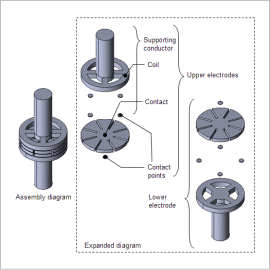
Vacuum circuit breakers have the function of breaking the current when a large current flows due to a short circuit or other reason in distribution boards, etc. Contact pressure is applied to the contacts in a vacuum circuit breaker because it is necessary for the vacuum circuit breaker’s contacts to be in contact and the electric circuit to be closed when normal current is flowing, unlike the large current from a short circuit.
Electromagnetic repulsion is produced by the current flowing in a vacuum circuit breaker’s contacts when current flows through the vacuum circuit breaker. Therefore, it is necessary to evaluate the electromagnetic repulsion and set the contact pressure higher than the electromagnetic repulsion in order to maintain a closed state during normal current.
This Application Note presents how to obtain the electromagnetic repulsion in a circuit breaker from the Lorentz force when a 100 kA current is flowing.
Electromagnetic repulsion is produced by the current flowing in a vacuum circuit breaker’s contacts when current flows through the vacuum circuit breaker. Therefore, it is necessary to evaluate the electromagnetic repulsion and set the contact pressure higher than the electromagnetic repulsion in order to maintain a closed state during normal current.
This Application Note presents how to obtain the electromagnetic repulsion in a circuit breaker from the Lorentz force when a 100 kA current is flowing.
Current Density Distribution
Current density distributions are shown in figures 1, 2, and 3. The current that flows into the supporting conductor of the lower electrode divides in the coil and flows to the contact via the contact points as shown in (a). Then, the current that has flowed into the contact is concentrated at the contact point as seen in (b). When current flows into the contact of the upper electrode from the narrow contact points, it tries to spread out as shown in fig. 3.
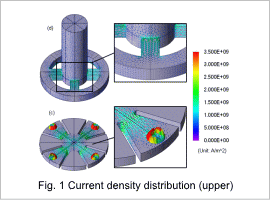
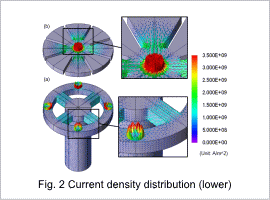
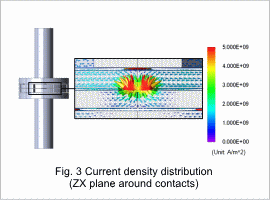
Lorentz Force Density Distribution and Electromagnetic Force
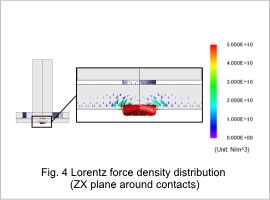
The Lorentz force density distribution is shown in fig. 4. Vertically repulsive force is generated in the contacts by the current flowing as shown in fig. 3.
Electromagnetic repulsion of approximately 700 N is generated in the contacts.
Electromagnetic repulsion of approximately 700 N is generated in the contacts.


